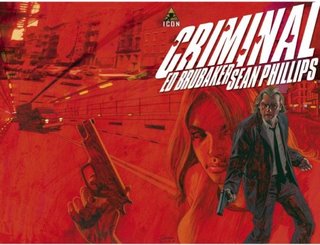Graphic Lit: "Criminal"

Back about two years ago, writer Ed Brubaker and artist Sean Phillips created what can easily be described as one of the best superhero comics ever made with “Sleeper,” a gritty noir story of intrigue and double-crossings that focused more on character development and good storytelling than impressive slugfests.
While the series garnered much critical attention, it didn’t do well in the sales department and was canceled, albeit in a rather satisfactory fashion, after about 24 issues.
Both creators moved on to bigger, if not necessarily better, things. Brubaker quickly became a fan favorite upon moving to Marvel and penning “Captain America” and “Daredevil.” Phillips provided art for the hugely successful “Marvel Zombies” miniseries.
Now the pair are back together with a new, ongoing series: “Criminal,” the flagship title for Marvel’s new creator-friendly Icon line.
“This is just us figuring out a way to do the kind of comics we’ve been wanting to do for a long time,” Brubaker said during a recent interview from his home in Seattle. “I have a notebook filled with crime story ideas and character notes for years I’ve been wanting to get to.”
Like “Sleeper,” “Criminal” is a dark, hard-boiled tale of morally corrupt people. Unlike the former series, though, there are no guys with special powers to speak of here. This is pure noir.
To that extent, “Criminal” adheres to well-worn crime story tropes. The main character, Leo, is a hard-nosed thief who’s given up trying for the big score and settles for picking pockets and easy marks.
That all changes when a pair of crooked cops coerce him into an offer that seems too good to be true (and probably is).
Anyone who’s read an Elmore Leonard or Jim Thompson novel will be on familiar territory here, but Brubaker and Phillips are doing more than just going through some well-worn paces.
“The reason I like genre stuff is it has a template for you to tell your story within,” Brubaker said. “Within that you can tell a much wider story that says a lot about people and human nature. I think crime fiction in general says a lot about society.”
The first issue explodes with unique, colorful characters. Brubaker’s dialogue is tight and focused yet manages to offer plenty of small moments necessary to canvass the various personalities onstage.
Phillips, meanwhile, keeps things moving at a brisk pace by sticking to a simple three-tier system and dividing the page into neat, narrow panels with lots of extreme close-ups.
“Sean felt like he needed the storytelling to be really clear and straightforward,” Brubaker said. “Sean, more than anybody I’ve ever worked with, understands the rhythmn of the dialogue.”
The result is a sharp, smart comic that rises above the genre’s cliches to create something fresh and exciting, making “Criminal” one of the best new series of 2006.
“We’re trying to make sure the book is worth $3 that people pay for comics these days,” Brubaker said. “I feel like that’s a lot of money to spend on something these days.
“The goal is to sell enough copies that we can keep doing it.”
Also in stores
“Pride of Baghdad”
by Brian K. Vaughan and Niko Henrichon
Vertigo, 136 pages, $19.99.
Loosely based on true events, Vaughan’s story follows some hungry lions that escape from a Baghdad zoo during the U.S. invasion of Iraq.
I’m not entirely sure the political allegory works, or at least completely jibes with what’s going on in that country right now. There’s more than mere colonialism at work there, though that certainly is a lingering issue.
That being said, Vaughan manages to make the animals into compelling characters, and Henrichon’s art is lovely to gaze at. At the risk of being flip, I’d say this is the best book about talking lions in Iraq you’ll ever read.
“American Spendor”
by Harvey Pekar, Dean Haspiel and more
Vertigo, $2.99 per issue.
Everyone’s favorite crank returns to the title that started it all with this four-issue limited series from DC.
Pekar is in good form here as he discusses his parents’ descent into Alzheimers, minds his daughter for a day and is dressed down by an airline stewardess.
As longtime readers know, it’s not what happens in “Splendor” that matters — nothing rarely ever happens. Rather it’s Pekar’s inner life, his constant turmoil, ruminations and anxieties, that make the book worthwhile. Nice art by folks like Haspiel, Ty Templeton and Hilary Barta doesn’t hurt either.
Copyright The Patriot-News, 2006

0 Comments:
Post a Comment
<< Home